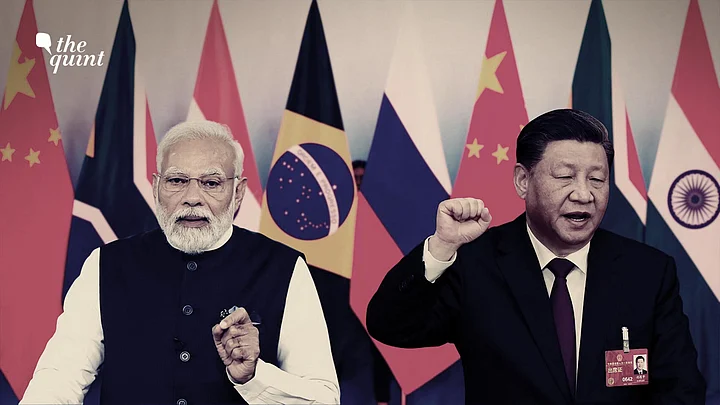Invariably, economic surveys are readable documents prepared by economic advisors, whose prescriptions are seldom followed by bureaucrats when they are drafting the budget. This time around, the economic survey for the year 2024-25 that was tabled on the floor of the House had an unusual suggestion. Simply stated, it asked the Indian government to cosy up to the Chinese economy by finding a “balance between importing goods from China and importing capital (FDI) from China.”
How did this suggestion to work closely with China come up when Prime Minister Narendra Modi refused to go to the Shanghai Cooperation Organisation meeting that took place in Kazakhstan’s capital, Astana, in the first week of July, and seemingly did not want to be seen alongside President Xi Jinping?
Informed sources claim that the prime minister was all set to go to Astana and seemed to have made all the preparations, but for some reason, suddenly backed off. These sources claim that the presence of Xi was the reason.
If that was indeed the case then why, to the annoyance of the strategic community, has the desire to do business with China suddenly shown up in the Economic Survey even when Beijing continues to beef up its military presence along the Line of Actual Control (LAC) and show no real remorse over either the violence at Galwan in 2020 or occupying Indian land in Ladakh?
New Delhi’s stated position is that it would not cooperate with the Chinese till it withdrew its troops from the LAC. This is visibly not true. Sources claim that the attempts at rapprochement with China were driven by the spike in violence in the Jammu region, which used to be peaceful for a long time.
There is a view, leavened by intelligence, that the surge in terrorist violence in Jammu is a manifestation of a two-front conflict that China and Pakistan are waging against India. This theory goes that India was compelled to move its troops from Jammu to Ladakh after China amassed its troops at the border. The absence or depleted presence of the Indian army at the border opened up many safe corridors for terrorists.
Despite the US providing important visuals and other proofs to New Delhi to establish how China has been enlarging itself at the Ladakh and Arunachal border, the Indian establishment has the width in its policy to work with China.
It is following its policy of “strategic autonomy” which the uncharitable claim is bending in the direction of those who put more pressure. Others more supportive of this policy claim that it is India’s old non-alignment policy without the ideological trappings. This allows New Delhi to do business without any guilt with the US, Russia, and China simultaneously.
India's total trade with China, which has grown quite a bit after the pandemic, is $120 billion. There has also been a spurt in exports that rely on Chinese inputs. Informed sources say that Modi's hasty trip to Moscow to meet President Vladimir Putin after the former did not show up at Astana’s SCO meet was more to find a fix for the looming China threat rather than look for a solution to Russia's protracted war with Ukraine.
While there is no mention of China in the joint statement with Russia, there have been plenty of meetings, lately, between Indian and Chinese foreign ministers. Diplomatic sources claim that Foreign Minister S Jaishankar has been tasked to represent a view that is contrary to all the behind-the-scenes manoeuvres undertaken by the likes of National Security Advisor Ajit Duval. Expectedly, Jaishankar talks about the trouble at the border and the imperative to sort out the long pending dispute between the two neighbouring countries, whereas others in the top echelons of the Indian establishment try to manage China in other ways.
Interestingly, Chinese Foreign Minister Wang Yi has chosen to ignore his Indian counterpart's assertion that Beijing should withdraw its troops from the LAC. Understandably, in the Chinese readout of what transpired in the meeting between Jaishankar and Wang Yi at the recent ASEAN meet, there is no suggestion that the border dispute was even discussed.
Diplomatic sources claim that China does not want India to step out of BRICS or the Shanghai Cooperation Organisation (SCO). It troubles Beijing when New Delhi draws close to the US or works towards beefing up the four-member Quad, which is seen to be an anti-China construct. It draws hope when India shows reluctance to call Quad a military alliance or works towards its dilution. New Delhi, however, leverages the strength the Quad gives even when it triggers China’s provocative moves (like allegedly in Jammu).
There is, though, great merit in India and China collaborating on infrastructural projects and more. India needs $1.7 trillion investment in infrastructure. A 2022 World Bank report suggested that India needed to spend $55 billion every year for 15 years to join the First World. The Indian government spends only $16 billion every year. How will the shortfall be met? By the looks of it, it’s not coming from the US or any other country in the West.
China, according to some voices in Delhi, is the only country that can give these kinds of funds, but its track record is dismal as witnessed in how it used debt to subvert the sovereignty of countries that were built along its trillion-dollar Belt and Road Initiative. India has refused to join the BRI but Beijing realises that its fancy project will remain a non-starter till India is part of it.
The big question, however, remains - will we see any change in our policy towards Chinese investment?
(The author is the editor of Delhi's Hardnews magazine. This is an opinion piece and the views expressed above are the author’s own. The Quint neither endorses nor is responsible for them.)
